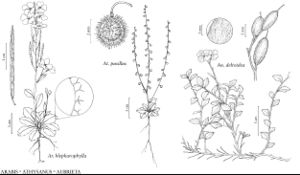Aubrieta deltoidea
Syst. Nat. 2: 294. 1821.
Plants forming mats or cushions; densely pubescent, trichomes stellate, mixed with fewer, setiform and forked ones. Stems several from base (caudex), ascending to procumbent, 0.7–3(–5) dm, pubescent. Basal leaves: petiole 0.1–1 cm; blade obovate, oblanceolate, or rhombic, (0.5–)1–3(–4.5) cm × (2–)4–13(–20) mm, base cuneate to attenuate, margins entire or 1–3 teeth on each side, surfaces densely pubescent. Cauline leaves: petiolate or (distalmost) sessile; blade similar to basal. Racemes 1–13-flowered, (lax). Fruiting pedicels erect to ascending, 5–12(–16) mm. Flowers: sepals 6–10 × 1–1.5 mm; petals (10–)15–28 × 4–7(–8) mm, (attenuate to claw, 5–12 mm); filaments 5–10 mm; anthers 1.2–1.6 mm. Fruits terete or slightly flattened, 0.7–2(–2.8) cm × 2–4(–4.8) mm; valves: trichomes long-setiform and forked, mixed with smaller, stellate ones; style 4–12 mm. Seeds 1.2–16 × 0.7–1 mm. 2n = 16.
Phenology: Flowering Apr–Jun.
Habitat: Rock crevices
Elevation: ca. 1600 m
Distribution

Introduced; Calif., s Europe (Mediterranean region), sw Asia, nw Africa.
Discussion
Aubrieta deltoidea is known as an escape from the Mt. Hull area at the Mendocino-Lake counties boundary. It is highly variable in its native range, and several infraspecific taxa have been recognized.
Selected References
None.
